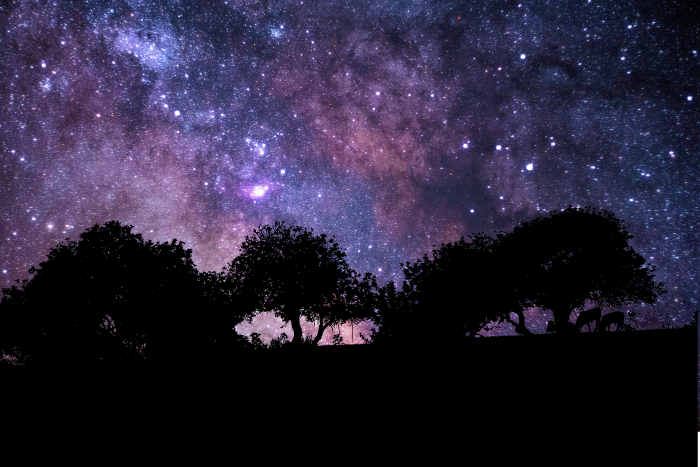By John L. Turner
If you’re like most people you’ve always had at least a mild interest in the constellations of the night sky and may have even taken a crack at identifying some of the constellations in the Northern Hemisphere. Well, here’s MY crack at providing a method for you to learn some of the constellations and other night objects during the winter season when the sky is clearer and generally contains less atmospheric moisture.
A future column will be devoted to learning the Summer constellations.
A great jumping off point to learn the winter constellations and sky objects is the constellation of Orion (the Hunter), perhaps the most conspicuous constellation of all. Orion is hard to miss with its three prominent stars in a line forming the hunter’s belt and the four prominent stars that form its shoulders and knees.
Above the belt and to its left, forming Orion’s right shoulder, is Betelguese (pronounced beetle juice), a red giant (and it does look reddish) which is estimated to be about 400 times the size of our sun and 3,000 times as bright! Forming the hunter’s left knee is Rigel, another bright star, but unlike Betelguese it burns a bright blue-white. Orion’s right arm is holding an identifiable club and his left arm is holding a shield to fend off Taurus the Bull which is next door.

The three straight-in-line belt stars of Orion hold his sword, which “hangs” from the central belt star. This area is rich in star formation and your binoculars (and if you don’t have binoculars remember the holiday season is coming) will show a fuzzy cloud, the result of the collective light of the stars in the region. The Great Nebula is situated here.
If you follow the three stars of the belt to your left (east) and down you’ll soon arrive at the brightest star in the heavens — Sirius, the Dog Star located in the constellation of Canis Major, the Big Dog. It is almost twice as bright as the next brightest star, Canopus, a star of the Southern Hemisphere. Sirius means “blazing” in Greek, an apt description given its luminosity.
Use the three belt stars of Orion heading in the opposite direction and you’ll head toward Taurus the Bull; continue in a line and you’ll come to a group of tightly packed bright stars — the “Pleiades” which looks like a tiny Big Dipper for which it is occasionally mistaken. The Pleiades star cluster (also known as the Seven Sisters, although the seventh star is hard to see) is the logo of Subaru, the car manufacturer, something you can confirm the next time you pull up to a Subaru at a light.
Below and to the left of the Pleaides you’ll see another reddish star — Aldebaran, which is the eye of the Bull, as it is rushing toward Orion. A little above and to the right of this red star is another star cluster — The Hyades. This is the closest star cluster to the Earth, a mere 150 light years away (that’s still pretty far at 900 trillion miles away for those who are curious) meaning the light you see emanating from these stars began their travel across the vast expanse of space in 1871.
Taurus has two other fascinating objects — the Crab and Horsehead Nebulas; the former is barely visible with 10x binoculars while the latter (which indeed looks like the head of a raging stallion facing left) requires much more powerful instruments. The Crab Nebula is thought to be the remains of a supernova that exploded back in 1054, an event that Chinese astronomers made note of (some reports suggest that the supernova was 500 million times as bright as our sun during its explosion).
In the middle of this nebula, in the aftermath of this cataclysmic explosion, exists a neutron star. Neutron stars are incredibly dense objects and in the “really, really hard to believe they’re real category” please note that a square inch of neutron star material is thought to weigh about 3 billion tons; yes that’s billion with a “b.” Taken from a Wikipedia account regarding neutron stars: “A neutron star is so dense that one teaspoon of its material would have a mass about 900 times the mass of the Great Pyramid of Giza.” This is one of many bizarre features existing in the Universe in which we live!
On especially clear nights, when sufficiently dark, if you look above Orion (just above Betelguese) you might notice a diffuse, irregularly shaped band of white that runs across the sky. This “milky” band is the light of tens of billions of stars that collectively make up the Milky Way Galaxy, the galaxy in which our Solar System resides. If you imagine the galaxy as being shaped like a pinwheel with slender arms, our solar system is situated about half way out on one of the arms. Scan the Milky Way with your binoculars and you’ll be instantly overwhelmed by the sheer and blinding number of stars, varying pinpricks of light in the velvety blackness.
 When I last looked at the Milky Way, a couple of days ago, it reminded me of our most humble place in the universal ethos and of a famous line by the poet Robinson Jeffers: “There is nothing like astronomy to pull the stuff out of man, His stupid dreams and red-rooster importance: let him count the star-swirls”.
When I last looked at the Milky Way, a couple of days ago, it reminded me of our most humble place in the universal ethos and of a famous line by the poet Robinson Jeffers: “There is nothing like astronomy to pull the stuff out of man, His stupid dreams and red-rooster importance: let him count the star-swirls”.
A resident of Setauket, John Turner is conservation chair of the Four Harbors Audubon Society, author of “Exploring the Other Island: A Seasonal Nature Guide to Long Island” and president of Alula Birding & Natural History Tours.





